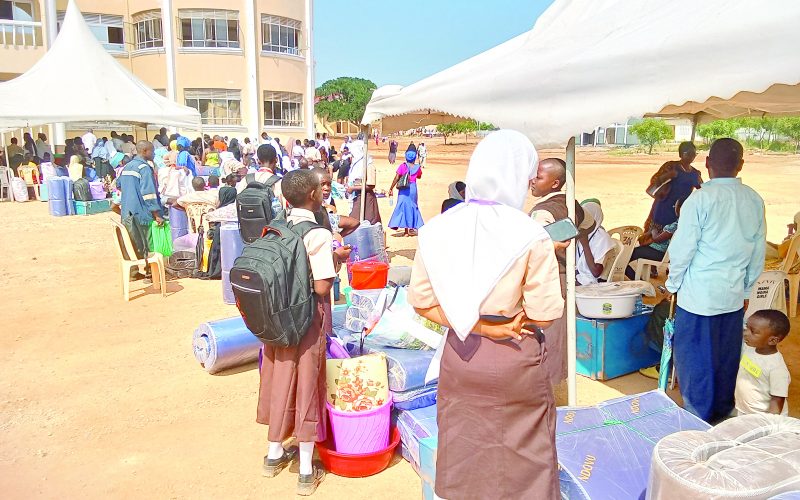Schools burst at the seams as Form 1 students report

Packed like sardines. This best captures learning conditions in most secondary schools after students reported to Form One last month.
Secondary schools are grappling with massive congestion as the government tries to push through the 100 per cent transition policy.
Inadequate infrastructure and staff shortage have become a major crisis in public schools across the country after thousands of learners reported to Form One to meet the transition target.
The situation is further exacerbated by the fact that this was the last Form One class under the 8-4-4 system as the country gradually moves to the competency-based education.
Cardinal Otunga High school chief principal Albert Ombiro said the school has been overwhelmed by the high enrollment and has been forced to turn some classrooms into dorms.
The principal also said some offices have been converted into classrooms to accommodate the high number of students while others study under tents.
“We have 3,000 students and we are creating more space to ensure the students have a good learning environment,” said Ombiro.
He said two dormitories were under construction.
It is a similar situation at Kereri Girls High School, with the principal, Tabitha Mogonchi saying they have had to accommodate more students in classrooms than the required 45 to cope with the high enrollment.
She said the school had turned all buildings in the school into extra classrooms and dorms to accommodate all learners, estimated at about 3,200.
“We need more classrooms as well as expand our laboratories and libraries to cope with the high enrolment,” Mogochi told People Daily on phone.
Free day school
In Kisii, County Director of Education (CDE), Philip Chirchir said chiefs and education officers had launched a mop up campaign to ensure the county achieves 100 per cent transition from primary to secondary school in line with the government’s policy.
Chirchir urged parents who are unable to raise fees to take their children to nearby schools where they can benefit from the Free Day Secondary Education.
“Parents are only required to buy uniform and arrange for lunch for their children,” Chirchir said.
In the North Rift, a majority of secondary schools are also struggling with acute congestion. Some schools have converted laboratories, libraries and dining halls into dormitories.
At Kapsabet Boys, the administration said facilities had been overstretched due to the huge student population.
School Principal Kipchumba Maiyo said they are undergoing a lot of pressure in accommodating learners. The school admitted 750 new students this year compared to 600 last year.
“We had to admit everybody because this was the last class under 8-4-4 system. Our hands are tied because we cannot overburden parents with extra levies,” said Maiyo.
Many parents have been seeking admission at the school owing to exemplary performance in the KCSE over the years.
It is a similar situation at nearby Kapsabet Girls High School whose results have also been improving. So is the situation at Uasin Gishu High School and Moi Girls High School, Eldoret.
Hygiene concerns
At Uasin Gishu High, the school has been forced to rearrange the classroom to cope with the new population, having admitted 500 students.
“We have moved students in senior classes to relatively small classrooms so that we move Form Ones who are over 70 in a class to bigger classrooms,” said the school principal Hosea Bett.
At Moi Girls, the management has converted tents to a dining hall to cope with the high student population.
In Mombasa, schools like Mvita boys, Allidina Visram and Alfarsy Secondary are among those that are struggling with huge number of admissions against glaring infrastructural challenges.
Classrooms are accommodating 50 to 60 students, a figure the staff describe as overwhelming.
“Where there are 60 students in one class, individualised education is difficult,” a teacher who sought anonymity said.
Besides learning, other facilities like toilets are also overstretched to an extent of almost compromising hygiene.
In an effort to balance the ratio of teachers to students, school managements have pushed the burden to parents for more funds to employ Board of Management (BOM) teachers.
At Mama Ngina Girls in Shanzu, there was also a high enrollment with the school chief principal Mwanahamisi Omar saying they targeted to admit 250 students for five streams.
“The process started well, we have so far admitted 180 students and we expect to admit about 250, we have enough space for that number of students as you know we have relocated to our new compound,” said Omar.
The national school will now occupy a 20-acre land near Shimo La Tewa Secondary, which is the only other national school in Mombasa County.
The principal reiterated that the school has a teaching staff deficit for their 1,055 students.
In the Western region, some principals say extra tuition fees, which the government has banned, was the main source of funding for salaries for non-TSC teachers.
The ministry of education allows BoMs to hire to bridge the tutor/learner ratio.
St Peters Mumias Boys school principal Christinus Owino said: “We are understaffed. Our curricular based establishment (CBE) gives 102 teachers but we only have 80 on TSC payroll. We have hired 24 more who we pay from income from projects and school savings.”
He said 880 Form One learners were admitted this year, above the 600 mark, pushing the student population to 2,810.
St Ignatius Mukumu Boys principal Sylvester Ashioya said Mukumu is eight-streamed as per the CBE registration but with a population of 2,350, including 780 Form Ones, parents have had to pay salaries for BoM teachers.
Outside the box
Milka Buchichi, a principal of St Mary’s Mumias Girls also said schools are struggling with crowded classes and dormitories.
“We have a deficit of 23 teachers and 10 classrooms. Some 600 girls are currently housed at an incomplete high-rise dormitory,” she said.
This year, Kakamega School admitted 1,000 Form One students, to add to a population of 2,000 in other classes.
“You need to think outside the box to cope with this high enrollment. You see, this school is endowed with facilities but the Form One class alone is equal to the entire Kakamega School population of the 1990s – 2012,” Kakamega School principal Julius Mambili explained.
He says the school had to convert a dining hall into a dormitory and construct prefabs form one class to make space for students.
“As we speak, we are in a deficit of ten classrooms. Our class numbers range between 75 and 80,” Buchichi observed.


